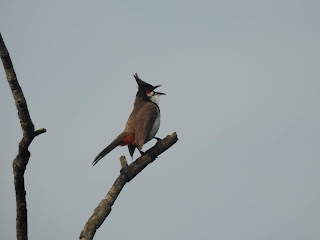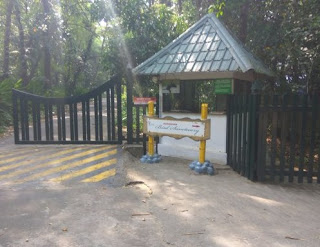Gray langur
Gray langurs are large and fairly
terrestrial, inhabiting forest, open lightly wooded habitats, and urban areas on the
Indian subcontinent.
Characteristics
These langurs are largely gray (some more yellowish), with a black
face and ears.
Externally, the various species mainly differ in the
darkness of the hands and feet, the overall color and the presence or
absence of a crest.
Typically all north Indian gray langurs have their tail tips looping
towards their head during a casual walk whereas all south Indian and Sri
Lankan gray langurs have an inverted "U" shape or a "S" tail carriage
pattern.

There are also significant variations in the size depending on the sex,
with the male always larger than the female.
Langurs mostly walk quadrupedally and spend half their time on
the ground and the other half in the trees. They will also make bipedal
hops, climbing and descending supports with the body upright, and leaps.
Distribution and habitat
The entire distribution of all gray langur species stretches from the
Himalayas in the north to Sri Lanka in the south.
They inhabit
arid
habitats like deserts, tropical habitats like tropical rainforests and
temperate habitats like coniferous forests, deciduous habitats and
mountains habitats.
Ecology and behavior
Gray langurs are
diurnal. They sleep during the night in trees but also on man-made structures like towers and electric poles when in human settlements.

When resting in trees, they generally prefer the highest branches.
Langurs are preyed upon by
leopards,
dholes and
tigers.
Wolves,
jackals and
pythons may also prey on langurs.
Gray langurs are primarily herbivores.
However, unlike some other colobines they do not depend on leaves and leaf buds of herbs, but will also eat
coniferous needles and cones, fruits and fruit buds, evergreen
petioles, shoots and roots, seeds, grass,
bamboo,
fern rhizomes,
mosses, and
lichens.
Leaves of trees and shrubs rank at the top of preferred food, followed
by herbs and grasses.
Non-plant material consumed include spider webs,
termite mounds and insect larvae.
Although they occasionally drink, langurs get most of their water from the moisture in their food.
Social structure
Gray langurs exist in three types of groups:
- one-male groups, comprising one adult male, several females and offspring;
- multiple-male groups, comprising males and females of all ages;
- all-male groups.
All-male groups tend to be the smallest of the groups and can consist
of adults, subadults, and juveniles. Some populations have only
multiple-male groups as mixed sex groups, while others have only
one-male groups as mixed sexed groups.

Some evidence suggests multiple-male groups are temporary and
exist only after a takeover, and subsequently split into one-male and
all-male groups.
Social hierarchies exist for all group types. In all-male groups, dominance is attained through aggression and mating success.
With sexually mature females, rank is based on physical condition and age.
The younger the female, the higher the rank. Dominance rituals are most common among high-ranking langurs.
Most changes in social rank in males take place during changes in group
members. An adult male may remain in a one-male group for 45 months. The rate of male replacement can occur quickly or slowly depending on the group.
Females within a group are matrilineally related. Female memberships are also stable, but less so in larger groups.
Relationships between the females tend to be friendly. They will do
various activities with each together, such as foraging, traveling and
resting.
Male and female relationships are usually positive. Relationships
between males can range from peaceful to violent. While females remain
in their natal groups, males will leave when they reach adulthood.
Relationships between groups tend to be hostile. High-ranking males
from different groups will display, vocalize, and fight among
themselves.
Reproduction and parenting
In multiple-male groups, the
highest-ranking male fathers most of the offspring, followed by the
next-ranking males and even outside males will father young.
Higher-ranking females are more reproductively successful than lower-ranking ones.
Female gray langurs do not make it obvious that they are in
estrous. However, males are still somehow able to deduce the reproduction state of females.

The
gestation period of gray langur lasts around 200 days,
Females usually give birth to a single infant, although twins do occur. Infants are born with thin, dark brown or black hair and pale skin.
Infants spend their first week attach themselves to their mothers'
chests and mostly just suckle or sleep.
They do not move much in terms of locomotion for the first two weeks of
their life. As they approach their sixth week of life, infants vocalize
more.
Vocalizations
- loud calls or whoops made only by adult males during displays;
- harsh barks made by adult and subadult males when surprised by a predator;
- cough barks made by adults and subadults during group movements;
- grunt barks made mostly by adult males during group movements and agonistic interactions;
- rumble screams made in agonistic interactions;
- pant barks made with loud calls when groups are interacting;
- grunts made in many different situations, usually in agonistic ones;
- honks made by adult males when groups are interacting;
- rumbles made during approaches, embraces, and mounts;
- hiccups made by most members of a group when they find another group.

>>----THANKS FOR VISITING MY BLOG...KEEP IN TOUCH------>

























































